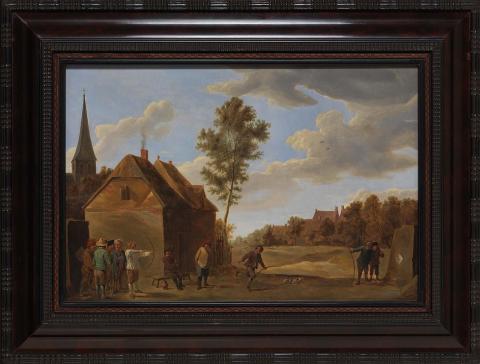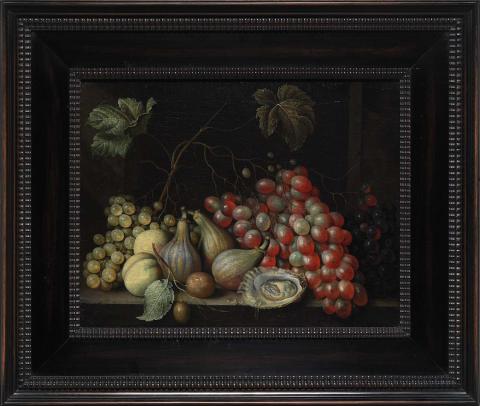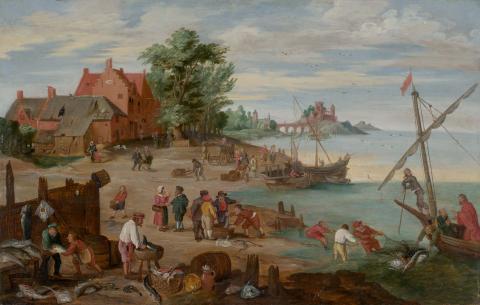ESSAY: The Bequest of Thomas Lodge Murray-Prior
By Geraldine Kirrihi Barlow
‘Plenty’ June 2023
Cultural sensitivity warning
QAGOMA would like to respectfully advise Aboriginal and Torres Strait Islander readers that this essay, pertaining to the Collection Focus ‘Plenty’, contains references to massacres and mentions of derogatory language.
On his death, British-born settler Thomas Lodge Murray-Prior left a group of Flemish and Dutch paintings to the newly formed state of Queensland. When the Queensland National Art Gallery opened in 1895, his bequest was the nucleus of our Collection. These treasured paintings had travelled with Murray-Prior over the course of his life, from relative precarity to his final position as a man of wealth and reputation, father to 20 children and a prominent member of the Queensland Parliament.
Flemish and Dutch painting of the sixteenth and seventeenth centuries recalls a ‘Golden Age’ and is renowned for still lifes of flowers, Chinese porcelain, wine and fruit. Seasonal produce features alongside rare and exotic species, conveying a sense of plenty as well as alluding to the fragility of life, wealth and power.
In the period 1854–59, Murray-Prior’s paintings adorned his family’s simple slab-bark hut at Hawkwood, or Ngairin Station, in the North Burnett region — remote then but now just six hours’ drive north-west of Brisbane. Murray-Prior’s daughter, Rosa Praed, described her childhood home where, between these paintings, ‘there were slots cut in the slab walls through which aperture a rifle could be used for protecting the inhabitants from [local Indigenous peoples]’.*
Frontier Wars between recently arrived settlers and First Nations peoples resulted in multiple massacres of Indigenous peoples across Queensland, which are only lately being acknowledged. After a neighbouring family, the Frasers, were killed, Murray-Prior led a group of settlers in attacks on the local Jiman people and rode for a time with the European-commanded paramilitary Native Police, made up of First Nations people who were often coerced into service, far from their traditional Country.
Symbols of European empire, these Flemish and Dutch paintings, brought to Australia in the mid-1800s, were also witness to the frontier wars. Here, they are displayed in dialogue with a painting from the period by Eugene von Guérard and works by contemporary First Nations artists with their own familial experience of these events — Bidjara/Ghungalu/Garingbal artist d Harding and Mbarbarrum artist Jennifer Herd.
Art can carry difficult historical truths; sometimes these are consciously framed and sometimes they are quietly carried within the material history of the work. Collection Focus ‘Plenty’ (on display 2023–24) seeks to provide insights into some of the founding aspirations of Australia as a nation, and the complex inheritances since, including the silences we still work to reconcile.
*Text in parentheses replaces language now considered derogatory.
Connected objects

Madonna and Child encircled by roses c.1650s
- KESSEL the Elder, Jan van - Collaborating artist (flowers)
- VOS, Circle of Simon de - Collaborating artist (Madonna and Child)

Madonna and Child encircled by flowers and fruit c.1615
- DANIELSZ, attrib. to Andries - Collaborating artist (flowers and fruit)
- STUDIO OF FRANS FRANCKEN THE YOUNGER - Collaborating artist (Madonna and Child)

Still life c.1650s
- DE BRYER, Cornelis - Creator

Still life c.1650
- COOSEMANS, Alexander - Creator

Holy Family with the infant Baptist c.1617-37
- BAROCCI, after Federico - Creator (original)
- ANTWERP SCHOOL 17th century - Creator (copy)
Digital Stories highlighting this narrative
![An installation view of ‘Plenty’, featuring the Gallery’s [Frame] 1959 by James Bourlet & Sons, London; and the 1860 Tower carbine rifle comprising Repatriation effort: this is not mine to bear 2016 by artist d harding (Bidjara/Ghungalu/ Garibal peoples) / Courtesy: The artist and Milani Gallery, Brisbane / Photograph: C Callistemon, QAGOMA An installation view in a dark room with gallery walls painted black; an empty gold frame on the wall, in the centre of the photo, frames the darkness; beneath it, a rifle is displayed in a glass cabinet.](/system/files/styles/large/private/2023-10/QAG_G7-9_installationview_20230403_ccallistemon_011.jpg?itok=wWGaxSBE)
ESSAY: ‘Plenty’
Read digital storyMetadata, copyright and sharing information
About this story
- Subject



